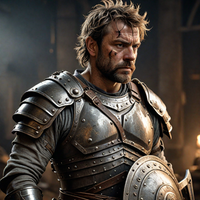LotR is running Pathfinder 2e under the hood, by the sounds of it, using Proficiency Without Level.
Data scientist, video game analyst, astronomer, and Pathfinder 2e player/GM from Halifax, Nova Scotia.
- 14 Posts
- 159 Comments

 1·10 days ago
1·10 days agoOk, that’s brilliant and awesome. Brisome.
I see. So, you have sticky pages and centrefolds.
Oh, so it’s that kind of dragon book. ( ͡° ͜ʖ ͡°)

 5·12 days ago
5·12 days agoempathicvagrant@lemmy.world Backstory is probably the wrong concept for a low-level character. They, instead, have a background. Backstories are prequel fodder, while backgrounds are used to figure out character motivation, and how a character reacts to future events.
Generally speaking, you don’t want to fill in blanks you don’t need filled i, because it’s creatively limiting your future self. If the events that got you to Session 1 are too interesting, you’ve probably written too much.

 10·13 days ago
10·13 days agoensignwashout@startrek.website I don’t know, zero-to-hero is one of the best story tropes out there. Totally nullifying it seems kind of wild to me. But you have to know who you’re playing, and if you’re playing a highly skilled veteran with a rich history of great deeds, you need to understand that that is not a Level 1 character.

 24·13 days ago
24·13 days agoI’ve become increasingly convinced that people don’t want to play low level characters. Level 1 characters are neophyte adventurers. Their backstory shouldn’t include significant a mounts of adventure, combat, or heroics, because it introduces a significant amount of ludo-narrative dissonance into the campaign.
Unless there’s a reason they’ve been de-leveled.
They made $50 million just on the playoff revenue sharing, and the amount of merch they moved over this playoff run probably pays for Cease outright. I’m sure they have a truck full of cash ready for Bo.

 1·28 days ago
1·28 days agoThis is functionally what Fellmarrow is doing in Narrative Declaration’s Kingmaker 2e actual play.

 4·1 month ago
4·1 month agoHeating on reentry is actually due to compressing the air in front of you, not friction. Falling from orbitall height will absolutely cause you to heat up the air in front of you, even as the air paassing you by is doing you no harm.
Though, if you smash into the atmosphere at orbital speeds, it’s probably going to do you some harm as it tries to force you back down to TV.
100%. They were sloppy as hell. I just know where all of the attention is right now, and didn’t want to give it any more.
I’m not going to lie: I purposefully chose not to talk about baserunning, because the baserunning that everyone wants to talk about right now is IKF’s in the 9th, and I don’t think there’s any issue with what he did there. He could have taken a slightly longer leadoff. He could have tried running through the plate (though, I’m not at all convinced that sliding is actually slower, since you still need to get your foot down on the plate, not just over it, and there isn’t strong evidence that running through is faster). But these were not mental mistakes, they were hedges that didn’t pay off.
Bo, Springer, and possibly Barger (it’s not clear to me whether Kike faked Barger out by starting deeper in the field and inching in or not) made some incredibly embarrassing mental mistakes on the bases, but IKF’s been getting all of the hate, and I don’t think he deserves it.

 4·1 month ago
4·1 month agoThat was a tough loss. They were so close so many times. They were two outs away. They were one fly ball away. They were one swing away.
If they had just lost, I’d be disappointed, but it’d mostly be nothing. The fact that they had it within their grasp multiple times last night, though, just absolutely burned out my adrenal system.
TTRPGs are games where you create stories, and sometimes those stories are “we did something we shouldn’ta, and someone got ganked”. What you’re describing is someone reading you a story book.

 7·1 month ago
7·1 month agoShohei’s been scuffling the last few games. He didn’t pitch a stellar game 4, and he’s seemed a little beat up at the plate. There’s a real opportunity to continue the pressure from the late innings yesterday in the early game today.
I hope they’re patient at the plate today, and ready to jump on mistakes, not just high fastballs and cutters in the dirt.

 3·1 month ago
3·1 month agoI reallly thought George was going to wall it off. I thought Giminez had hit a bloop single. I thought we were going to see 1st and 3rd with one out, amd I thought George was completing the season of his life.
I really, really thought it was happening.
Now I’m just exhausted.

 4·1 month ago
4·1 month agoGreat start to the game! Gaus’s pitches are moving!
Well, not every game has Heroic Inspiration, but it still has people that gripe about secret rolls. And of those games that have metacurrencies for rerolls and the like, they’re not intended to be used in those situations.

thegreatdarkness@ttrpg.network Sure. You should be able to use LotR to explain the rules of any fantasy RPG system, really.